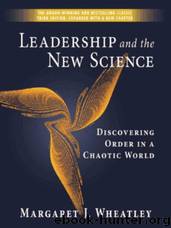Leadership and the New Science by Wheatley Margaret J

Author:Wheatley, Margaret J.
Language: eng
Format: epub
ISBN: 9781605091471
Publisher: Berrett-Koehler Publishers
Fractals are . . . complex by virtue of their infinite detail and unique mathematical properties (no two fractals are the same), yet they’re simple because they can be generated through successive applications of simple iterations. . . . It’s a new brand of reductionism . . . utterly unlike the old reductionism, which sees complexity as built up out of simple forms, as an intricate building is made out of a few simple shapes or bricks. Here the simple iteration in effect liberates the complexity hidden within it, giving access to creative potential. The equation isn’t the plot of a shape as it is in Euclid. Rather, the equation provides the starting point for evolving feedback. (Briggs and Peat 1989, 104; italics added)
The process of fractal creation suggests some ways organizations can work with the paradox that greater openness is the path to greater order. A fractal reveals its complex shape through continuous self-reference to a simple initial equation. Thus, the work of any team or organization needs to start with a clear sense of what they are trying to accomplish and how they want to behave together. I think of these agreements as the initial equations (see also Chapter Seven). Once this clarity is established, people will use it as their lens to interpret information, surprises, experience. They will be able to figure out what and how to do their work. Their individual decisions will not look the same, and there is no need for conformity in their behavior. But over time, as their individual solutions are fed back into the system, as learning is shared, we can expect that an orderly pattern will emerge.
At all levels and for all activities in organizations, we need to challenge ourselves to create greater access to information and to reduce those control functions that restrict its flow. We cannot continue to use information technology and management systems as gatekeepers, excluding and predefining who needs to know what. Instead, we need to evoke contribution through freedom, trusting that people can make sense of the information because they know their jobs, and they know the organizational or team purpose. Restricting information and carefully guarding it doesn’t make us good managers. It just stops good people from doing good work. Jan Carlson, former head of Scandinavian Airlines and one of the pioneers in the customer service revolution, says it clearly: “An individual without information cannot take responsibility, but an individual who is given information cannot help but take responsibility” (Willett 1999). Information provides true nourishment; it enables people to do their jobs responsibly and well.
Probably the most startling example of an organization that is redesigning itself because of increased access to information is the U.S. armed forces. Both the Army and the Marines now have the technology to provide every individual soldier with information about what’s occurring on the battlefield, information that formerly was known only by the commanders. Through extensive field tests, the Army has discovered that when individuals have such information and
Download
This site does not store any files on its server. We only index and link to content provided by other sites. Please contact the content providers to delete copyright contents if any and email us, we'll remove relevant links or contents immediately.
Hit Refresh by Satya Nadella(8328)
The Compound Effect by Darren Hardy(7544)
Change Your Questions, Change Your Life by Marilee Adams(6635)
Nudge - Improving Decisions about Health, Wealth, and Happiness by Thaler Sunstein(6629)
The Black Swan by Nassim Nicholas Taleb(6182)
Daring Greatly by Brene Brown(5636)
Deep Work by Cal Newport(5451)
Principles: Life and Work by Ray Dalio(5315)
Rich Dad Poor Dad by Robert T. Kiyosaki(5140)
The Myth of the Strong Leader by Archie Brown(4785)
Man-made Catastrophes and Risk Information Concealment by Dmitry Chernov & Didier Sornette(4728)
Big Magic: Creative Living Beyond Fear by Elizabeth Gilbert(4716)
The Slight Edge by Jeff Olson(4715)
Discipline Equals Freedom by Jocko Willink(4629)
The Motivation Myth by Jeff Haden(4521)
Digital Minimalism by Cal Newport;(4508)
Stone's Rules by Roger Stone(4412)
Management Strategies for the Cloud Revolution: How Cloud Computing Is Transforming Business and Why You Can't Afford to Be Left Behind by Charles Babcock(4127)
The Doodle Revolution by Sunni Brown(4034)
